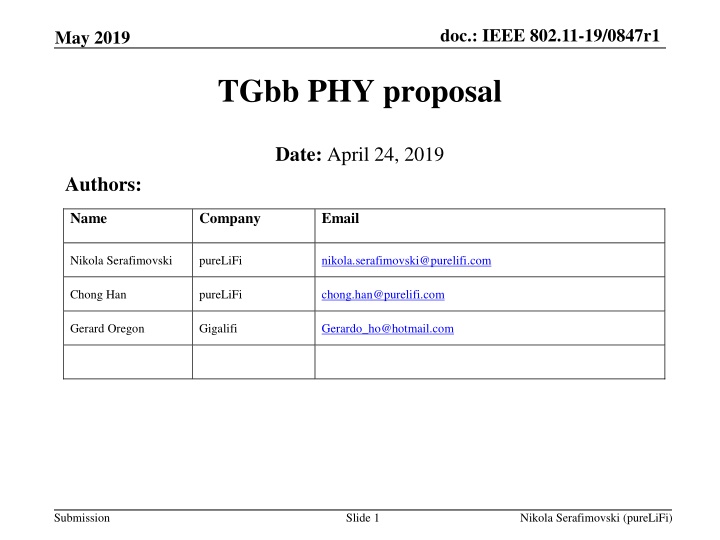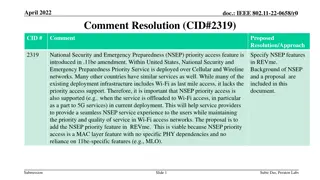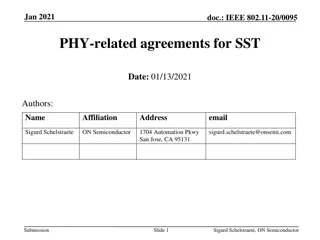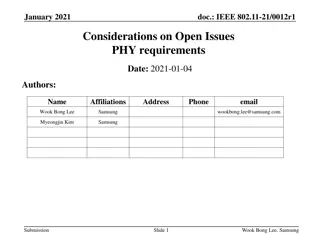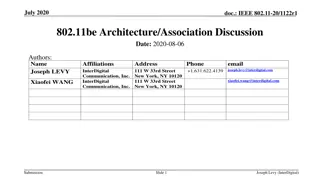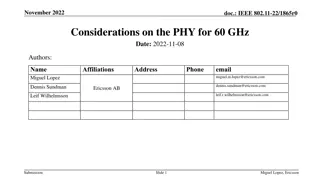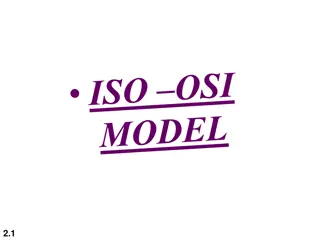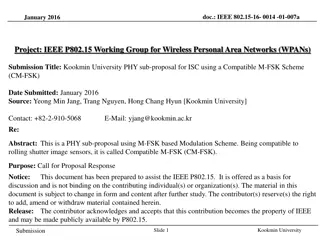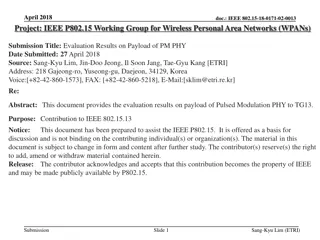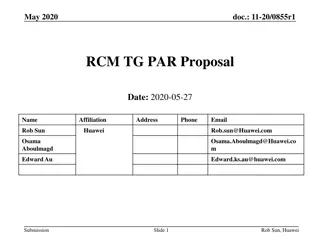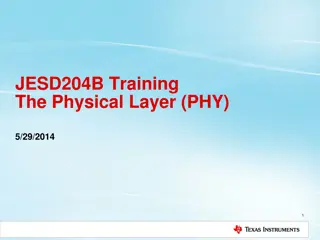Proposal for Integration of PHY Layer Enhancement in IEEE 802.11 Standards
This proposal suggests integrating a new PHY layer to improve throughput and robustness in frequency-selective channels, complementing existing IEEE 802.11 specifications. The document outlines the characteristics, options, and feasibility of applying the proposed enhancements within the framework of IEEE standards.
Uploaded on Oct 09, 2024 | 1 Views
Download Presentation

Please find below an Image/Link to download the presentation.
The content on the website is provided AS IS for your information and personal use only. It may not be sold, licensed, or shared on other websites without obtaining consent from the author.If you encounter any issues during the download, it is possible that the publisher has removed the file from their server.
You are allowed to download the files provided on this website for personal or commercial use, subject to the condition that they are used lawfully. All files are the property of their respective owners.
The content on the website is provided AS IS for your information and personal use only. It may not be sold, licensed, or shared on other websites without obtaining consent from the author.
E N D
Presentation Transcript
doc.: IEEE 802.11-19/0847r1 May 2019 TGbb PHY proposal Date: April 24, 2019 Authors: Name Company Email Nikola Serafimovski pureLiFi nikola.serafimovski@purelifi.com Chong Han pureLiFi chong.han@purelifi.com Gerard Oregon Gigalifi Gerardo_ho@hotmail.com Submission Slide 1 Nikola Serafimovski (pureLiFi)
doc.: IEEE 802.11-19/0847r1 May 2019 Abstract This presentation aims to provide a suggestion on the integration of a PHY layer that could enable existing .11 PHY specifications to be applied for LC as well as the introduction of a new LC PHY to provide enhanced optimization for higher throughput and enhanced robustness in frequency- selective channels. Submission Slide 2 Nikola Serafimovski (pureLiFi)
doc.: IEEE 802.11-19/0847r1 May 2019 Introduction TGbb pre-proposal was discussed in do. 11-19/0388r0. Submission Slide 3 Nikola Serafimovski (pureLiFi)
doc.: IEEE 802.11-19/0847r1 May 2019 LC PHY Options Existing 802.11 PHY - 20-160 MHz - bit-interleaved coded modulation - existing IEEE 802.11 technology - more advanced MIMO schemes LC-optimized PHY - 25 200 MHz - closed-loop adaptive bitloading - existing ITU-T G.vlc technology - good performance in frequency- selective channel - needs liaison btw. IEEE and ITU-T Main difference Pro Con - suboptimal performance in frequency-selective channel Submission Slide 4 Nikola Serafimovski (pureLiFi)
doc.: IEEE 802.11-19/0847r1 May 2019 Characteristics of LC PHYs LC requires a non-negative and real-valued baseband-signal. Bipolar signals can be turned non-negative by adding a DC- bias before transmission. optical channel + RX DSP TX DSP Driver & LED High- pass Photo- diode DC It is removed by using a high-pass filter before reception. Submission Slide 5 Nikola Serafimovski (pureLiFi)
doc.: IEEE 802.11-19/0847r1 May 2019 Option 1) Use existing 802.11 PHYs for LC Complex OFDM-baseband signals are real-valued after up- conversion to the carrier frequency fc. Up-con- version Data LED Re(.) CP IFFT fc For LC, one could simply change fcto a low carrier ( low IF ), yielding a real-valued baseband signal. Submission Slide 6 Nikola Serafimovski (pureLiFi)
doc.: IEEE 802.11-19/0847r1 May 2019 Using existing 802.11 PHYs for LC (2) RF frontend up-converts baseband signals onto e.g. fc=2.4 GHz. LC frontend up-converts baseband onto low IF e.g. fc=BW/2 + . is to be agreed depending on signal mask design. This way, any complex-valued baseband signal (i.e. any existing IEEE 802.11 PHY) can be used to facilitate LC. Submission Slide 7 Nikola Serafimovski (pureLiFi)
doc.: IEEE 802.11-19/0847r1 May 2019 PROPOSAL: Baseband-offset ( ) Straw Poll: Should the mandatory baseband offset ( ) for existing 802.11 PHY modes as described in Slide 6 be set to 1.5 MHz for TGbb? Y/N/A 3 / 5 / 9 Submission Slide 8 Nikola Serafimovski (pureLiFi)
doc.: IEEE 802.11-19/0847r1 May 2019 Option 2) Use a LC-optimized PHY The LC-optimized PHY benefits from adaptive bitloading Adaptive bitloading is widely used in LC R&D papers Brings enhanced mobility support and optimized PHY performance Seamless operation in both, LOS and NLOS channel conditions Ways to bring adaptive bitloading into 802.11 Integrate G.hn as LC-optimized PHY under 802.11 MAC Submission Slide 9 Nikola Serafimovski (pureLiFi)
doc.: IEEE 802.11-19/0847r1 May 2019 Use existing and LC-optimized PHY under 802.11 MAC 802.11 MAC could integrate existing and optimized PHY 802.11 MAC LC-Optimized PHY Existing PHY for LC Use existing 802.11ax PHY as a common, mandatory OFDM PHY. Negotiate the use of the LC-optimized PHY if both devices have that capability. Submission Slide 10 Nikola Serafimovski (pureLiFi)
doc.: IEEE 802.11-19/0847r1 May 2019 PROPOSAL: Use 11ax PHY as the common-mode for TGbb Straw Poll: Should the 11ax (High Efficiency PHY specification) be used as a mandatory, common-mode for TGbb? Y/N/A 1 / 7 / 10 Submission Slide 11 Nikola Serafimovski (pureLiFi)
doc.: IEEE 802.11-19/0847r1 May 2019 References [1] V. Jungnickel, V. Pohl, S. Nonnig and C. von Helmolt, "A physical model of the wireless infrared communication channel," in IEEE Journal on Selected Areas in Communications, vol. 20, no. 3, pp. 631- 640, April 2002. https://mentor.ieee.org/802.11/dcn/18/11-18-1237-02-00bb-ieee-802- 11bb-reference-channel-models-for-vehicular-communications.pdf ITU-T recommendation G.9660-2015 P. W. Berenguer, V. Jungnickel and J. K. Fischer, "The frequency-selective rate adaptation communications," 2016 10th Communication Systems, Networks and Digital Signal Processing (CSNDSP), Prague, 2016, pp. 1-6. [2] [3] [4] benefit of for optical Symposium wireless International on Submission Slide 12 Nikola Serafimovski (pureLiFi)
